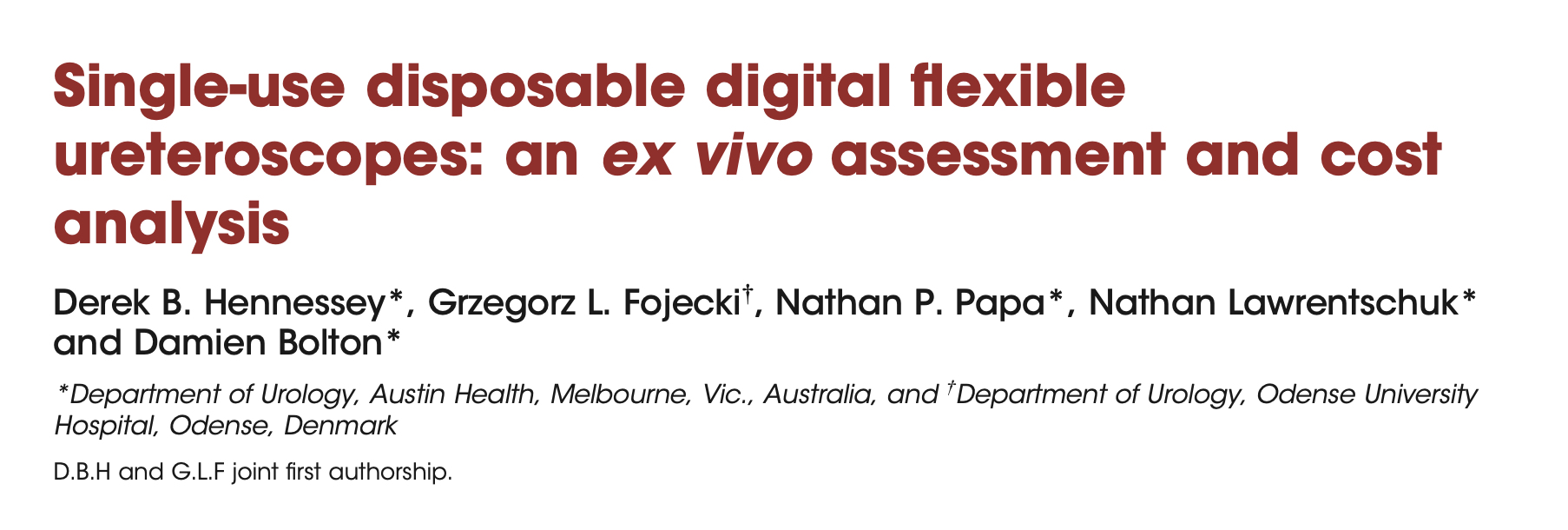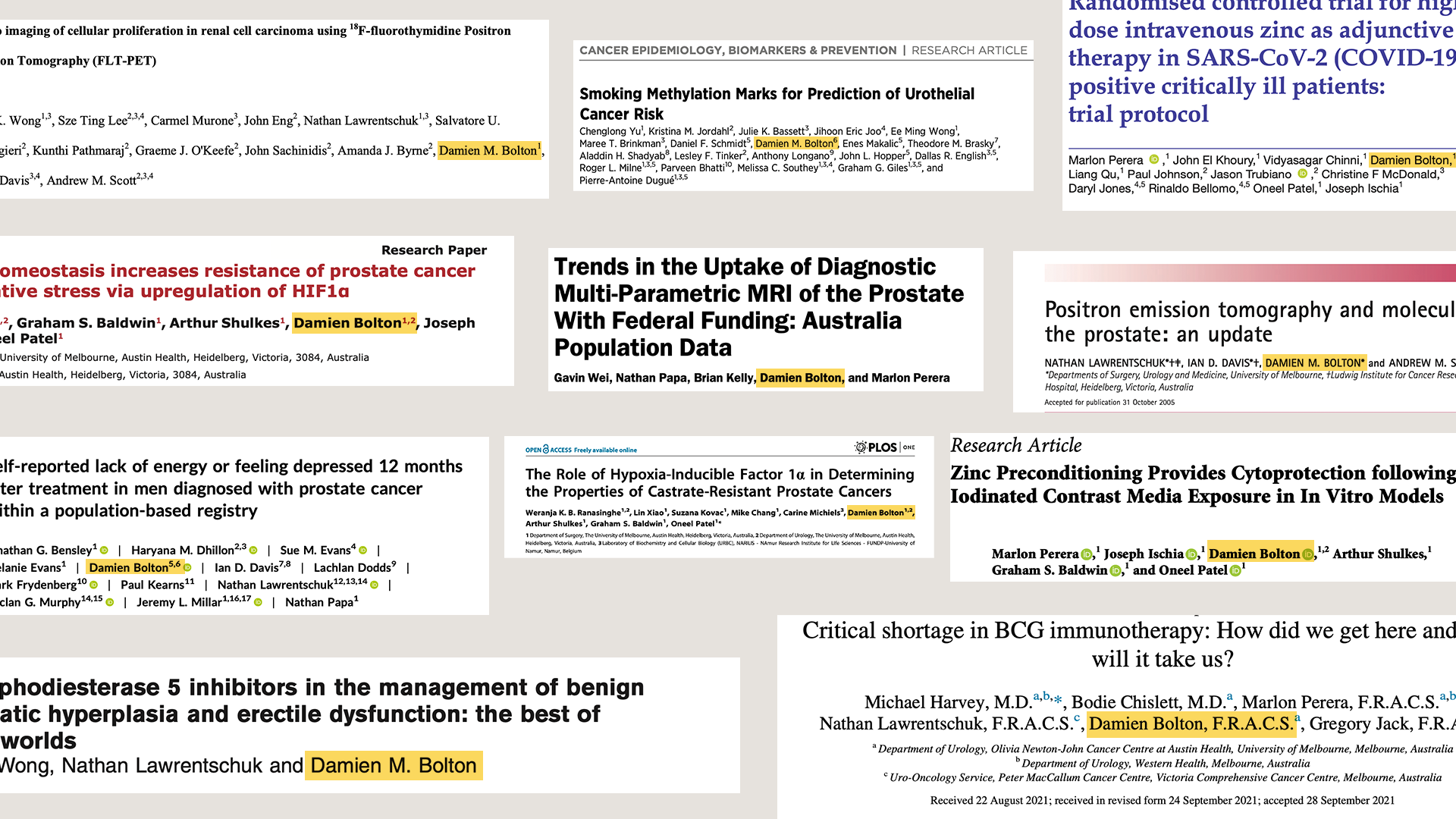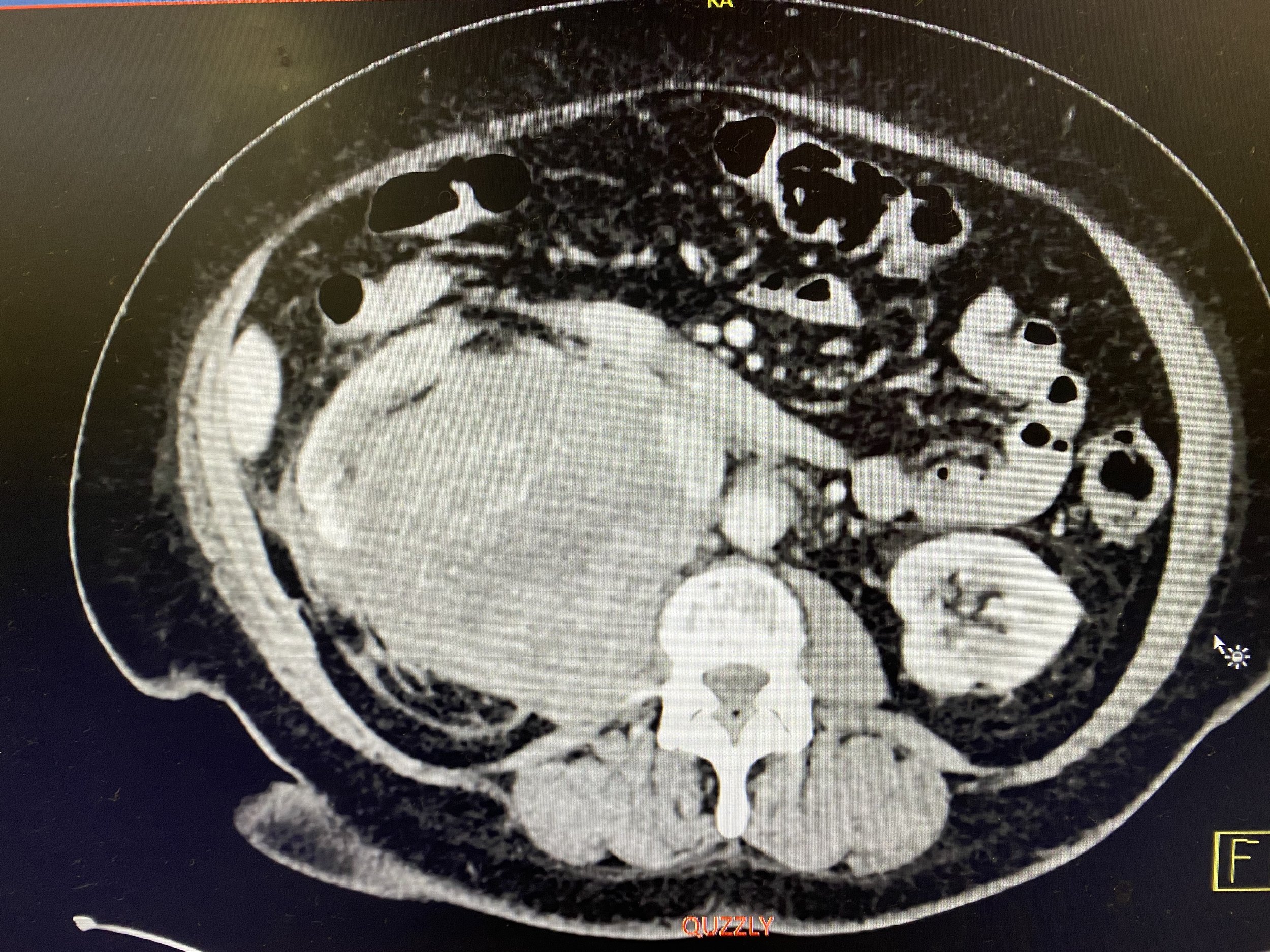My Research.
Research has always been a source of fascination and motivation to me, ever since I was a medical student. With over 450 publications producing more than 12,500 citations (H-index 56), 18 book chapters, 12 patents and over $10 million dollars in research grants, I have found this the best way to truly understand a concept in medicine. Medical research is also by its nature such a collaborative and inquisitive process that it gives rise to great personal relationships with peers, and an insight into the issues in other research concepts more broadly. Copied below are details of some interesting published studies and links to some manuscripts available as open access publications.

Further Clinical Trial Involvement
Damien Bolton has been a member of the editorial board of many of the most significant journals in urology. These include Journal of Endourology, BJU International, and World Journal of Urology where he currently serves as corresponding editor. In addition he has been a reviewer for multiple other journals including Nature, Lancet, New England Journal of Medicine, Journal of Urology, European Urology, Medical Journal of Australia and Journal of Obstetrics and Gynaecology, and a grant reviewer on multiple occasions for NHMRC, Cancer Australia and other philanthropic groups.
Links to some of the current clinical trials he is involved with as an investigator are listed below.
-

Smoking Methylation Marks for Prediction of Urothelial Cancer Risk
A self-reported study designed to evaluate whether smoking-associated DNA methylation markers improve urothelial cell carcinoma (UCC) risk prediction.
-

Fine-needle Aspiration Cytology Study
A paper detailing the accuracy of fine-needle aspiration (FNA) cytology of palpable inguinal lymphadenopathy before definitive management of the primary tumour, in predicting inguinal lymph node (LN) metastasis in men with primary squamous cell carcinoma (SCC) of the penis.
-

Accessing 3D Printed Vascular Phantoms for Procedural Simulation
3D printed patient-specific vascular phantoms provide superior anatomical insights for simulating complex endovascular procedures. Currently, lack of exposure to the technology poses a barrier for adoption. We offer an accessible, low-cost guide to producing vascular anatomical models using routine CT angiography, open source software packages and a variety of 3D printing technologies.
-

Cross-continental comparison of safety and protection measures amongst urologists during COVID-19
A study to determine the well-being of urologists worlwide during the coronavirus disease 2019 pandemic, and whether they have adequate personal protective equipment, knowledge and supplies appropriate to their clinical setting.
-

Trends in the Uptake of Diagnostic Multi-Parametric MRI of the Prostate With Federal Funding
A paper aiming to assess the uptake of mpMRI and identify dis-crepancies across different states and patient populations across Australia, nationwide.
-

Investigation of hypoxia and carbonic anhydrase IX expression in a renal cell carcinoma xenograft model with oxygen tension measurements and I-cG250 PET/CT
Characterizing intratumoral hypoxia in a human RCC xenograft model using oxygen probe measurements; investigating if I-cG250 targets RCC correlating uptake on noninvasive positron emission tomographycomputerized tomography (PET-CT) against traditional biodistribution studies, and investigating CAIX expression in this RCC model.
-

Evaluation of pelvic floor muscle strength before and after robotic-assisted radical prostatectomy and early outcomes on urinary continence
The aim of the study was to evaluate the effect of pelvic floor muscle (PFM) assessment and training before and after robot-assisted laparoscopic radical prostatectomy (RARP) in improving PFM strength and urinary continence.
-

Multidetector computed tomography vs magnetic resonance imaging for defining the upper limit of tumour thrombus in renal cell carcinoma
A study and review comparing the findings of multidetector computed tomography (CT) with surgical pathology and magnetic resonance imaging (MRI), to determine the accuracy of delineating the superior extent of inferior vena cava (IVC) thrombotic involvement in renal cell cancer (RCC).
-

Not all prostate cancer is the same – patient perceptions: an Asia-Pacific region study
A study exploring the perceptions of patients living with different stages of prostate cancer across the Asia-Pacific (APAC) region.
-

Detection and localisation of primary prostate cancer using gallium prostate-specific membrane antigen positron emission tomography/computed tomography
Comparing the accuracy of gallium prostate-specific membrane antigen positron emission tomography/computed tomography (Ga-PSMA PET/CT) with multiparametric MRI (mpMRI) in detecting and localising primary prostate cancer when compared with radical prostatectomy (RP) specimen pathology.
-

Self‐reported lack of energy or feeling depressed 12 months after treatment in men diagnosed with prostate cancer within a population‐based registry
Feeling depressed and lethargic are common side effects of prostate cancer (PCa) and its treatments. We examined the incidence and severity of feeling depressed and lack of energy in patients in a population based PCa registry.
-

Gleason grade accuracy of transperineal and transrectal prostate biopsies in MRI‑naïve patients
Accurate assessment of Gleason grade is essential to guiding prostate cancer management. Not all healthcare systems have universal access to prostate MRI. We investigated whether transperineal (TP) prostate biopsies provide more accurate Gleason grading than transrectal (TR) biopsies in MRI-naïve patients.
-

The role of cystectomy in elderly patients – a multicentre analysis
A study outlining the complications and survival in surgical patients 80 years and over undergoing radical cystectomy for bladder cancer.
-

Zinc Preconditioning Provides Cytoprotection following Iodinated Contrast Media Exposure in In Vitro Models
Contrast media (CM) causes renal injury through both direct cellular injury (cytotoxicity) and regional vascular changes (renal hypoxia) mediated by reactive oxygen species (ROS). Zinc may be able to provide protection against CM-induced cytotoxicity due to its indirect antioxidant properties and subsequent effect on ROS.
-

Zinc supplementation as an adjunct therapy for COVID-19: Challenges and opportunities
In this review, we discuss the regulatory mechanism that hinges upon the bioavailability of zinc. Finally, we propose that intravenous zinc could circumvent the confounding factors affecting the bioavailability of zinc and allow zinc to achieve its therapeutic potential.
-

Decreased Prostate Cancer-Specific Survival of Men with BRCA2 Mutations
This paper examines how the role of a germ-line BRCA2 mutation in the development of prostate cancer is established, but the clinical presentation linked to outcome for this group of men has not been well described.
-

Tumor Size and Postoperative Kidney Function following Radical Nephrectomy
The aim of this study was to clarify inconsistencies in the literature regarding the prognostic significance of tumor size for postoperative kidney function.
-

Dysfunctional Lipid Metabolism
Advanced prostate cancer has a higher mortality rate at diagnosis compared to localised prostate cancer. As such, it is critical to understand the mechanisms of development, and potential pathways that may drive research into novel treatments. We aim to review how lipid metabolism relates to advanced prostate cancer.
-

Novel Germline Mutations
In this study, we identified germline mutations that contribute to prostate cancer development in men who have multiple relatives with prostate cancer (and other cancers). We correlated the genetic mutations found in each patient with the resulting prostate cancer characteristics.
-

Trial of high-dose intravenous zinc in hospitalised COVID-19 patients
Zinc inhibits replication of the SARS‐CoV virus. We aimed to evaluate the safety, feasibility, and biological effect of administering high‐dose intravenous zinc (HDIVZn) to patients with COVID‐19.
-

Social determinants of health
Socioeconomic status (SES), race and geographical factors are known to impact prostate cancer management and outcomes. We aimed to assess these factors with regard to access to novel imaging in prostate cancer.
-

Mechanism of Urosepsis
Documenting the histological changes observed in renal units subjected to elevated intrarenal pressures (IRPs) and postulate the possible mechanisms of infectious complications after ureteroscopy.
-

PCNL in Neurogenic Bladder
To review the management of patients with neurogenic bladder undergoing percutaneous nephrolithotomy (PCNL) at our institution with the aim of assessing peri-operative morbidity.
-

Single-use Disposable Digital Flexible Ureteroscopes
To assess and measure the capability of a single-use disposable digital flexible ureteroscope, the LithoVueTM (Boston Scientific, Marlborough, MA, USA), and to assess if there is a benefit to switching to single-use scopes.
-

Increased Prostate Cancer Specific Mortality after Radical Prostatectomy in Men with Voiding Symptoms
Whole of population studies reporting long-term outcomes following radical prostatec- tomy (RP) are scarce. We aimed to evaluate the long-term outcomes in men with prostate cancer (PC) treated with RP in a whole of population cohort. A secondary objective was to evaluate the influence of mode of presentation on PC specific mortality (PCSM).


